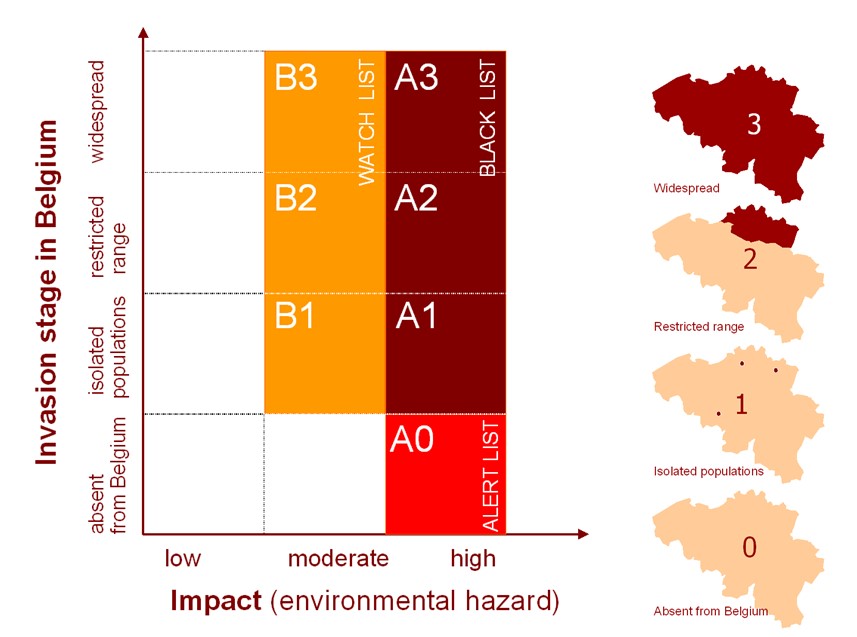Impact assessment of invasive alien plants in Belgium
The Belgian Forum on Invasive Species gathers scientific information on the presence, distribution, ecology and adverse impacts of invasive alien species. Information on alien species introduced by man on the Belgian territory or in neighbouring areas from 1500 to date is stored in a database called Harmonia. Species included in the system are allocated to different categories based on a simplified environmental impact assessment and geographical distribution in Belgium. It includes diverse taxonomic groups from terrestrial, freshwater and marine environments. Only organisms that are already established in Belgium or in neighbouring areas with similar eco-climatic conditions (Germany, Ireland, Luxembourg, Netherlands, Northern France, Switzerland and United Kingdom) are taken into consideration to be integrated in the system. The data included in the system refers as much as possible to available published literature and on-line databases dedicated to invasive alien species, and to information from field surveys.
The objective of this process is to group alien species into different categories and to identify those for which preventive and/or mitigation actions are necessary. Contrary to pest risk assessments protocols which are mainly based on species’ intrinsic attributes to evaluate invasion likelihood, this approach favours the use of documented invasion histories to assess their potential to cause adverse ecological effects in Belgium.
In this process, the 4 following factors (spread, colonization, impacts on native species and ecosystems) are assessed, and scores are attributed according to the level of risk which is perceived. In this scoring system, an equal weight is attributed to each item.
1. The potential of an organism to spread in the environment by natural means and/or by human activities:
Low risk: the species does not spread into the environment because of poor dispersal capacities and a low reproduction potential. E.g.: Aesculus hippocastanum, Zea mays
Medium risk: except when assisted by man, the species does not colonise remote places. Natural dispersal rarely exceeds more than 1 km per year. The species can however become locally invasive because of a strong reproduction potential. E.g.: Robinia pseudacacia
High risk: the species is highly fecund, can easily disperse through active or passive means over distances ;1km/year and initiate new populations. Are to be considered plant species that take advantage of anemochory (e.g. Senecio inaequidens), hydrochory (e.g. Ludwigia grandiflora), and zoochory (e.g. Prunus serotina).
2. The potential for an exotic species to colonise habitats with a high conservation value (irrespective of its dispersal capacities) – assessment is based on habitat preference information from native and invaded areas. Habitats with a high conservation value are those where disturbance by man is minimal, thus allowing specific natural communities and threatened native species to occur (see examples of habitats in annex 1 of the 92/43/EEC Directive):
Low risk: populations of the alien species are restricted to man-made habitats (low conservation value). E.g.: Setaria verticillata
Medium risk: populations of the alien species are usually confined to habitats with a low or a medium conservation value and may occasionally colonise high conservation value habitats. E.g.: Fallopia japonica, Robinia pseudoacacia, Solidago gigantea
High risk: the alien species often colonise high conservation value habitats and therefore are a potential threat for red-listed species. E.g.: Ludwigia grandiflora, Spartina townsendii.
3. The potential of alien species to have adverse impacts on native species is assessed. Impacts may include predation/herbivory, interference and exploitation competition, transmission of diseases to native species, genetic effects such as hybridisation and introgression with native species:
Low risk: data from invasion histories suggest that the negative impact on native populations is negligible.
Medium risk: the alien species is known to cause local changes (;80%) in population abundance, growth or distribution of one or several native species, especially among common and ruderal species. This effect is usually considered as reversible. E.g.: moderate competition of Senecio inaequidens with native species.
High risk: the development of the alien species often cause severe local (;80%) population decline and the reduction of local species richness. These alien species form long-standing populations and their impacts on native biodiversity are considered as hardly reversible. E.g.: strong interspecific competition in plant communities mediated by allelopathic chemicals (Fallopia japonica, Prunus serotina, Solidago spp.).
4. The potential to alter native ecosystems’ processes and structures in ways that significantly decrease native species’ ability to survive and reproduce is considered. Ecosystem impacts may include modification of nutrient cycling or resources (e.g. eutrophication), physical modifications of the habitat (changes of hydrologic regimes, increase of water turbidity, light interception, alteration of river banks, etc.), modification of natural successions and disruption of food webs (i.e. a modification of lower trophic levels through herbivory or predation leading to ecosystem imbalance):
Low risk: the impact on ecosystem processes and structures is considered as negligible.
Medium risk: the impact on ecosystem processes and structures is moderate and considered as easily reversible. E.g.: temporary modification of soil or water properties (Lemna spp.), decrease or increase of the rate of colonisation of open habitats by shrubs and trees (Pinus nigra).
High risk: the impact on ecosystem processes and structures is strong and difficult to reverse. E.g.: alteration of physico-chemical properties of water by invasive aquatic plants (Hydrocotyle ranunculoides, Ludwigia spp., Myriophyllum aquaticum), facilitation of river bank erosion (Impatiens glandulifera), prevention of natural regeneration of trees (Lonicera japonica, Prunus serotina, Rhododendron ponticum).
Figure 1: Categorization system to identify organisms of most concern for preventive and mitigation actions.
The global environmental risk is then addressed in the following way:
Score | Category | Description |
11-12 | A (Black list) | Includes species with a high environmental risk |
9-10 | B (Watch List) | Includes species with a moderate environmental risk |
4-8 | C | Includes other alien species that are not considered a threat for biodiversity |
Sources
E. Branquart (Ed.) (2007) Guidelines for environmental impact assessment and list classification of non-native organisms in Belgium.

